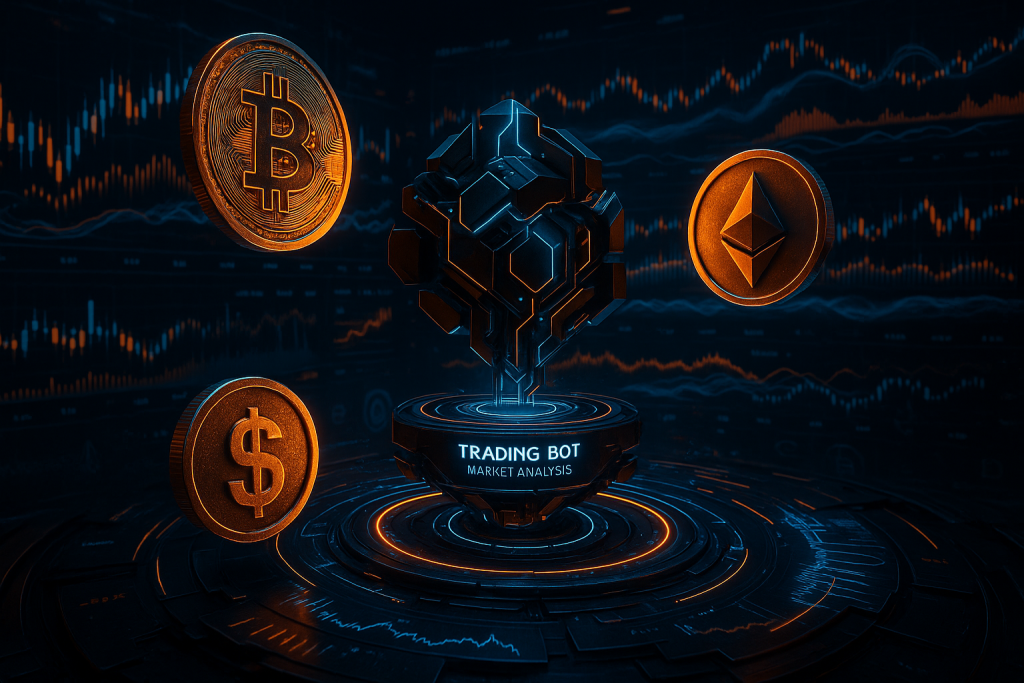Trading bot with market analysis

In today’s world of digital technologies and rapid financial market growth, automation has become an integral part of trading. One of the most prominent examples of technology in this field is the market analysis trading bot. It’s an intelligent programme capable of independently making buy or sell decisions based on data-driven market analysis.
The main purpose of a trading bot is to ease the trader’s workload, save time, and minimise human error. Unlike a human, a bot is unaffected by emotions, doesn’t get tired, and can operate around the clock, instantly responding to changes in the market environment. However, for these actions to be effective, deep market analysis is essential – and that’s precisely where modern bots excel.
Market analysis can involve both technical and fundamental approaches. Technical analysis relies on charts, indicators, trading volumes, and price patterns. Fundamental analysis considers economic news, company reports, interest rates, and geopolitical events. Advanced trading bots can combine both methods, using machine learning algorithms and artificial intelligence to make smarter decisions.
That said, trading bots are not magic nor a guarantee of profit. Their success depends directly on the quality of their algorithm, proper parameter setup, and continuous data updates. Furthermore, they can incur losses if market conditions change suddenly and the bot’s strategy becomes misaligned with the new reality.
One of the key benefits of a trading bot is its ability to respond instantly to market movements. It doesn’t need sleep, rest, or breaks. It can run 24/7, monitoring the market and executing trades even at night or during holidays – which is especially relevant for cryptocurrency markets, where trading never stops.
Trading is stressful. People often make mistakes driven by fear, greed, or panic. A trading bot, on the other hand, operates strictly according to its algorithm and is unaffected by emotions. This helps avoid impulsive decisions and maintain discipline in trading.
A bot can simultaneously analyse dozens of charts, indicators, news feeds, and statistical models. Doing that manually would take hours. Automation enables faster data processing and helps identify profitable opportunities that might otherwise go unnoticed.
Many strategies require rapid execution and precise condition compliance, which are difficult to achieve manually. Bots can employ complex algorithms, including arbitrage, scalping, grid strategies, and machine learning methods. All of this significantly broadens a trader’s toolkit.
Furthermore, a trading bot can operate across multiple exchanges, instruments, or strategies at once. This makes it possible to manage a large portfolio without losing oversight of individual trades.
Bots also allow backtesting – testing strategies on historical data. This gives traders the opportunity to verify their approach’s effectiveness before applying it in a live market. Additionally, parameters can be fine-tuned and optimised to suit current market conditions.
Category news: Markets and Instruments Product and Bot Features Trading Strategies
-

Bot for trading goods
In an era of rapidly advancing digital technology, businesses are increasingly turning to automated solutions that simplify and accelerate workflows. One such solution is trading bots – programs capable of replacing or complementing human labor in the sales process. Their integration into product trading offers a number of substantial advantages that significantly enhance business efficiency. […]
-

Real-Time Trading Bot
Real-time trading bots connect directly to trading platforms via API. They receive up-to-the-second data on prices, volumes, supply and demand, and use predefined algorithms to execute trades. These algorithms can be simple – for example, buying when the price drops and selling when it rises – or highly sophisticated, incorporating technical analysis, artificial intelligence, or […]
-

ETF Trading Bot
Thanks to rapid technological development, investing is gradually shifting from a domain reserved for professionals to an area of widespread public interest. Exchange-traded funds (ETFs), in particular, have grown extremely popular, offering diversification, transparency, and ease of purchase. Against this backdrop, a new tool is emerging – an ETF trading bot. ETF funds, or exchange-traded […]
-

Algorithmic trading bot
The use of trading bots in algorithmic trading has become a true breakthrough in the financial world. These intelligent systems offer a range of significant advantages, which is why they are increasingly replacing manual trading and opening up new horizons for market participants. Algorithmic trading is a method of automated buying and selling of assets […]
Latest news
-

Bot for trading goods
In an era of rapidly advancing digital technology, businesses are increasingly turning to automated solutions that simplify and accelerate workflows. One such solution is trading bots – programs capable of replacing or complementing human labor in the sales process. Their integration into product trading offers a number of substantial advantages that significantly enhance business efficiency. […]
-

SHIB
SHIB, or Shiba Inu, is a cryptocurrency that emerged in 2020, inspired by the popular meme coin Dogecoin. It quickly caught the attention of the crypto community thanks to its extremely low price per token and a marketing strategy centered around social media and fan engagement. Although SHIB was initially conceived as a “joke,” its […]
-

Real-Time Trading Bot
Real-time trading bots connect directly to trading platforms via API. They receive up-to-the-second data on prices, volumes, supply and demand, and use predefined algorithms to execute trades. These algorithms can be simple – for example, buying when the price drops and selling when it rises – or highly sophisticated, incorporating technical analysis, artificial intelligence, or […]
-

ETF Trading Bot
Thanks to rapid technological development, investing is gradually shifting from a domain reserved for professionals to an area of widespread public interest. Exchange-traded funds (ETFs), in particular, have grown extremely popular, offering diversification, transparency, and ease of purchase. Against this backdrop, a new tool is emerging – an ETF trading bot. ETF funds, or exchange-traded […]

